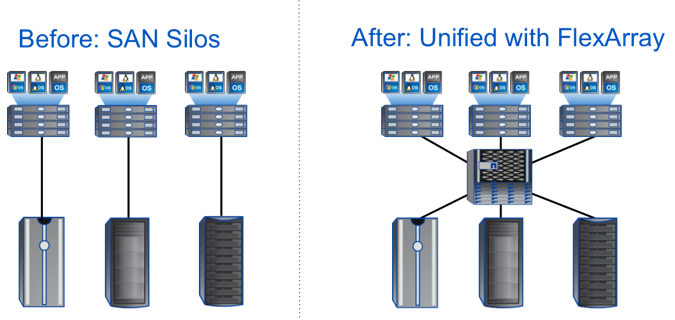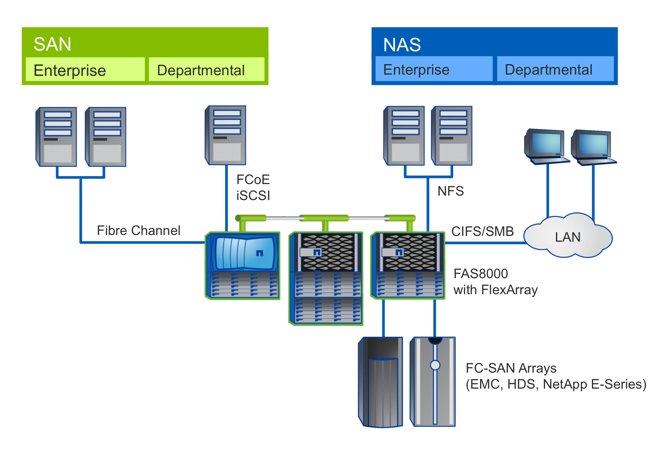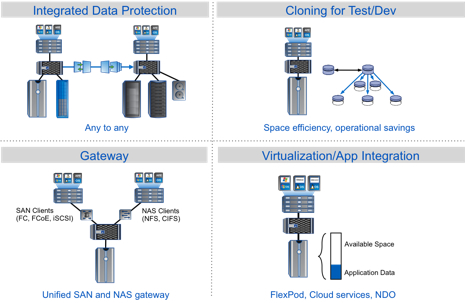


It's one of the oldest problems in IT. You carefully forecast your requirements, painstakingly select the right gear to meet those needs—and then things change. Maybe a big project fizzles, a project team overestimates its needs, or a requirement you didn't anticipate (maybe because it didn't exist a year ago) becomes important. No matter the reason, the result is the same: You're stuck with infrastructure that no longer quite fits the bill.
NetApp introduced its V-Series storage virtualization systems 10 years ago to address exactly these types of scenarios. NetApp virtualization teaches your old storage to do new tricks, such as nondisruptive operations, cloud enablement, NAS and SAN, replication, deduplication, and much more. In the process, silos of storage are eliminated, simplifying management and unifying your storage environment.

Figure 1) FlexArray software gives your existing storage new capabilities and eliminates silos of storage.
Now, with the introduction of FlexArray storage virtualization software, NetApp has integrated the full capabilities of our V-Series controllers as part of the FAS8000 platform. If you've followed NetApp for a while, you'll recognize this as a consistent pattern: We pioneer new capabilities and ultimately roll them into FAS, increasing its capabilities while delivering greater flexibility and value.
In this article, we describe FlexArray and its advantages in more detail, take a look at how FlexArray works, and explore some important use cases including nondisruptive operations and the cloud. We also look at the combination of FlexArray and NetApp® E-Series.
Introducing FlexArray Storage Virtualization

FlexArray storage virtualization software can run on any FAS8000 model to provide full virtualization for EMC, HDS, and NetApp E-Series arrays. By virtualizing your existing storage assets, FlexArray helps you unify and simplify your IT operations. It provides superior storage functionality and paves the way for software-defined storage while delivering proven efficiency and guaranteed return on investment (ROI).
FlexArray delivers the same capabilities as our existing V-Series controllers, with one important difference: You can add the software license and take advantage of FlexArray whenever you need it, without having to add a separate controller.
For example, suppose you deploy a FAS8000 today, and down the road your company acquires another company with HDS or EMC arrays. You can simply add FlexArray software licenses to your existing FAS8000 systems and virtualize some or all of those arrays, unifying management and, in effect, making the capacity part of your NetApp environment.
Here are some of the advantages of FlexArray software:
- Investment protection. FlexArray provides investment protection for existing arrays. If your existing storage lacks a crucial capability that the FAS8000 and the clustered Data ONTAP® operating system offer, you can virtualize all or part of the capacity on that storage array to gain that capability.
- Nondisruptive operations. Planning downtime is becoming impossible. Once you virtualize the capacity of your existing arrays with FlexArray, you can take advantage of NetApp nondisruptive operations capabilities for maintenance, upgrades, load balancing, and workload migration—you can move the data for a running application from one storage system (or one type of storage media) to another without downtime.
- Storage consolidation. FlexArray lets you consolidate your existing storage, unifying silos of SAN storage to create scalable capacity for both SAN and NAS workloads.
- Proven storage efficiency. FlexArray allows your existing arrays to benefit from the full Data ONTAP storage efficiency portfolio, including thin provisioning, deduplication, compression, Snapshot™ copies, thin replication, and thin cloning. For virtual server environments, we guarantee that you'll reduce the amount of data stored by at least 35% compared to the amount of data stored by traditional storage.
- Guaranteed ROI. Because of the storage savings that result from using NetApp storage efficiency on your existing storage, we guarantee that a FAS8000 with FlexArray will pay for itself in nine months or less.
FAS8000 hybrid storage provides the perfect hardware platform for FlexArray virtualization. Each FAS8000 model has been substantially enhanced in terms of processors, memory, flash and I/O capabilities, offering roughly twice the performance of the previous generation platform it replaces.
In addition, the FAS8000 includes on-board Unified Target Adapter 2 (UTA2) ports. These ports operate in either of two modes:
- 16Gb Fibre Channel
- Connect to existing arrays with maximum speed for optimum FlexArray performance.
- Connect to your SAN fabric and SAN hosts.
- 10GbE
- Provide high-speed Ethernet connectivity to client data networks.
- Provide iSCSI and/or FCoE connectivity for IP SAN hosts.
How FlexArray Works

Logically, you can think of a FlexArray configuration as having a front end and a back end. The front end includes FAS8000 controllers, plus connections to hosts, to tape devices, or to other FAS8000 controllers in a cluster. On the back end, FlexArray attaches to your existing storage arrays via Fibre Channel and provides a virtualization layer between the storage array and the hosts.
You create LUNs on your existing storage array(s) and present them to FlexArray. These LUNs are RAID protected by the storage array itself, typically using RAID 1, RAID 5, or RAID 6; that option is up to you.
FlexArray uses the LUNs assigned to it to create an aggregate (storage pool). RAID 0 (striping) is used to stripe data across all LUNs in an aggregate, enabling writes to be spread across multiple LUNs for performance.
Once LUNs are configured and attached, tasks such as provisioning and data protection are performed on the FAS8000 using NetApp tools, giving you a single interface for storage management tasks. From a management perspective, a FAS8000 with FlexArray looks like and is managed like any other NetApp system. You can create flexible volumes (FlexVol® volumes); NFS and CIFS shares; and iSCSI, FCP, and FCoE LUNs just as you would on NetApp disk. You can also use storage efficiency features like thin provisioning, deduplication, compression, and cloning, as well as Integrated Data Protection features including Snapshot, SnapMirror®, and SnapVault® technologies.
Here are a few of the finer points of the FlexArray architecture that are easy to overlook:
- You can virtualize part of an existing array. You don't have to attach all the storage from an existing array to a FAS8000 with FlexArray. You can assign some array LUNs to FlexArray and maintain other array LUNs for direct access by hosts.
- You can put multiple arrays behind FlexArray and the arrays can be from different vendors. Having to manage storage from multiple vendors can be complicated. Putting a FAS8000 with FlexArray in front of a set of heterogeneous arrays provides a single point of management, a uniform set of capabilities, and simplified management.
- You can use several FAS8000 systems with FlexArray as a front end to a single array. Depending on your needs you can put several FAS8000 controllers in front of a single back-end array. For instance, you might put several smaller FAS8000 controllers in front of a very large array.
- You can flash-accelerate the performance of virtualized storage arrays. The NetApp Virtual Storage Tier lets you deploy flash at the FAS8000-controller level (Flash Cache™ intelligent caching), or the aggregate level (Flash Pool™ intelligent caching, for NetApp disks only) to further optimize performance while minimizing cost.
- FlexArray works with clustered Data ONTAP. Clustered Data ONTAP allows you to join up to 24 NetApp controllers into a single scale-out cluster. It provides a wide range of capabilities that further enhance your IT infrastructure. With FlexArray, your existing storage becomes part of a NetApp cluster, with all the same capabilities.
- FlexPod configurations can incorporate FlexArray. Converged infrastructure solutions like the FlexPod® platform streamline the process of deploying new IT infrastructure. Including a FAS8000 with FlexArray in your FlexPod configuration allows you to incorporate existing storage capacity in a FlexPod platform.

Figure 2) FlexArray software makes existing arrays part of a NetApp scale-out infrastructure.
FlexArray Use Cases

A number of FlexArray use cases have been proven over many years in NetApp V-Series deployments. Several newer use cases, including nondisruptive operations and cloud enablement, are also becoming popular.
Primary Use Cases
IT teams choose NetApp virtualization to take advantage of NetApp's proven efficiency, Integrated Data Protection, and unified storage capabilities. Popular use cases include:
- Increasing the efficiency of virtualized environments. When provisioned using traditional methods, virtual server and desktop environments have a high degree of duplication. Virtualization with FlexArray can allow you to reclaim that capacity. We guarantee a 35% reduction compared to traditional storage.
- Enabling replication between arrays from different vendors. Array-based replication solutions typically require identical source and target configurations. FlexArray can allow you to replicate between heterogeneous arrays to achieve your replication goals while reducing bandwidth requirements.
- Creating more usable data copies for development and test operations. Dev/test typically requires many copies of production data. The virtual copy capability supported by NetApp FlexArray configurations using NetApp FlexClone® volumes lets you reduce the amount of storage needed to a fraction of what would otherwise be required, and you can create a usable "copy" in minutes.
- Acting as a NAS or SAN gateway. Often, you have capacity on block-based SAN storage, but you need NAS. Configuring file servers is one way to solve this problem, but a single FAS8000 with FlexArray can take the place of large numbers of file servers, reducing cost and complexity while increasing availability. At the same time it can also provide popular SAN protocols, including FC, FCoE, and iSCSI.
- Accelerating the performance of existing storage. Because of the additional level of controller cache and NetApp technologies such as write anywhere file layout (the WAFL® system) and Virtual Storage Tiering, the FAS8000 with FlexArray can actually drive significantly more I/O operations per second (IOPS) per drive than a native array alone in many cases.
These use cases are more fully described in the V-Series section of the Tech OnTap Back to Basics series.

Figure 3) Some common FlexArray use cases.
Nondisruptive Operations
A use case that has become popular recently is utilizing NetApp storage virtualization in order to take advantage of the nondisruptive operations capabilities of clustered Data ONTAP.
Taking downtime for software and firmware upgrades, component replacements, or maintenance or to add capacity is becoming difficult or impossible. FAS8000 with FlexArray running clustered Data ONTAP brings nondisruptive maintenance and lifecycle operations to your existing storage. You perform essential tasks during normal business hours without affecting applications or users, improving customer satisfaction and simplifying the lives of IT staff.
As an example, a leading automotive company with a variety of storage platforms needed to eliminate planned downtime. By virtualizing its existing storage the company was able to standardize management and eliminate the need for storage downtime.
Cloud Enablement
Your existing storage environment may lack the features you need to enable a private cloud—or to integrate with cloud service providers and hyperscale providers such as Amazon Web Services or Microsoft® Azure. Virtualizing your existing storage with FlexArray addresses these limitations.
Private cloud. The FAS8000 with FlexArray delivers a full suite of features that can be critical in cloud environments. This includes features such as native multi-tenancy, storage quality of service, simple storage provisioning, and workflow automation, in addition to the features we discussed above.
NetApp capabilities for deploying storage services in a private cloud are described in more detail in a recent Tech OnTap article. Everything you read there applies directly to storage virtualized with the FAS8000 and FlexArray.
Integration with cloud service providers and hyperscale providers. NetApp has taken an open approach to cloud integration, enabling seamless connectivity between clouds to integrate your private cloud with cloud service providers and hyperscale providers. Our cloud solutions offer:
- A universal data platform with standardized data services able to run on NetApp FAS hardware, third-party storage arrays via FlexArray and V-Series, and commodity hardware
- Dynamic data portability that allows you to efficiently move data between clouds
- Extensive choice that includes hundreds of cloud providers and all major virtualization and cloud management platforms—making it easier to select where, how, and with whom to deploy
Virtualizing your existing storage with FlexArray makes that storage part of the NetApp cloud ecosystem, creating new cloud options you may not have had before.
Virtualizing NetApp E-Series

You may be asking yourself, "Why would someone want to virtualize NetApp E-Series with NetApp FlexArray?" The fact is that we've enabled this capability in response to customer requests to support many of the same use cases already discussed.
- A large financial company virtualized its E-Series storage in order to support NetApp MetroCluster™ technology for continuous availability.
- A worldwide healthcare company had E-Series deployed in its main data center. By virtualizing some of the capacity on the E-Series and deploying FAS systems in remote locations, the IT team was able to replicate from remote locations to its E-Series storage.
Other customers have found that they have currently unused capacity on their E-Series storage systems deployed for Hadoop, full-motion video, and similar high-bandwidth, high-throughput environments. Virtualizing this free capacity gives them additional capabilities for SAN, NAS, backup/recovery, replication, and storage efficiency, without affecting the primary function of the E-Series arrays.
Conclusion

FlexArray software significantly extends the capabilities of the FAS8000, allowing you to virtualize existing storage arrays and integrate them as part of your NetApp storage environment, paving the way to software-defined storage. Because you can enable the license on any FAS8000 model at any time, FlexArray gives you even greater flexibility to adapt to unforeseen requirements and rapidly changing IT needs.
With a range of proven storage efficiency technologies, FlexArray allows you to recover storage capacity and slow the rate of storage growth. As a result, NetApp guarantees that the FAS8000 with FlexArray will pay for itself in nine months or less, making it a smart choice for situations in which you need to simplify your storage environment or enhance the capabilities of your existing storage.






